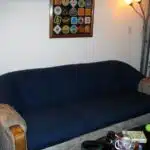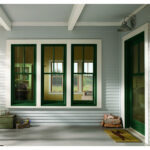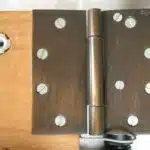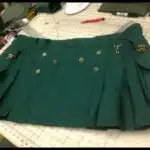Upholstering a door can be a creative and rewarding project for those who are passionate about DIY home decor. However, it requires meticulous attention to detail and precision in order to achieve the desired outcome. In this article, we will provide step-by-step instructions on how to upholster a door, including the necessary tools and materials needed for the job.
As an upholstery expert and instructor, I have seen firsthand the satisfaction that comes from completing a successful upholstery project. Upholstering a door is no exception – it can transform a plain or outdated doorway into a unique statement piece that adds character and style to any room. Whether you are looking to refresh your home’s interior design or simply enjoy the process of creating something with your own hands, mastering the art of door upholstery can be both fulfilling and enjoyable.
Choosing The Right Fabric For Your Door
Choosing the right fabric for your door is crucial in achieving a polished and cohesive look for your space. When selecting the fabric, there are two main factors to consider: texture and color coordination.
Firstly, texture plays an important role in the overall aesthetic of your upholstered door. The texture you choose should complement the style of your room and the existing textures within it. For example, if you have a room with a lot of smooth surfaces such as glass or metal, then choosing a textured fabric can add warmth and depth to the space. Conversely, if you have a room with a lot of textures already, such as exposed brick or rough wood, then opting for a smooth fabric could provide balance.
Secondly, color coordination is another vital element to consider when selecting your fabric. Choose colors that either match or complement the existing color scheme of your space. If you’re unsure what colors will work best, consider using a color wheel to help guide you in making your decision. It’s also worth noting that darker fabrics tend to hide dirt and stains better than lighter fabrics.
Once you’ve chosen your ideal fabric based on texture and color coordination, it’s time to measure the door and cut the fabric accordingly.
Measuring The Door And Cutting The Fabric
Accurately measuring the dimensions of the door is an essential first step in upholstering.
Mark the measurements on the upholstery fabric and use a cutting tool to cut the fabric to size.
To ensure an even cut, use a straight-edge ruler for any straight cuts and a curved ruler for curved edges.
Once the fabric is cut to size, use a staple gun to attach the fabric to the door.
After the fabric is attached to the door, make sure to smooth out any wrinkles and staple any excess fabric to the back of the door.
Finally, you can add any desired decorative elements, such as trim or buttons, to complete the upholstery.
Measuring The Door
Accurately measuring the door is crucial in ensuring a seamless and professional-looking upholstery job. Before starting, it’s important to gather all the necessary tools such as a tape measure, straight edge ruler, and a notepad to jot down your measurements. Measuring techniques may vary depending on the size and shape of your door, but it’s essential to take precise measurements from various angles.
One common mistake that beginners make when measuring their door is failing to account for any curves or uneven surfaces. When measuring a curved door, use a flexible tape measure and take multiple measurements at different points along the curve to ensure accurate measurements. Another mistake is not measuring the thickness of the door which can result in an ill-fitting upholstery job. Be sure to measure both the width and height of the door as well as its thickness to ensure that you have enough fabric for wrapping around all sides.
Lastly, before cutting your fabric, double-check your measurements and be sure to add extra inches on all sides for seam allowances. It’s better to have more fabric than less as you can always trim it down later on during the final stages of upholstering. By taking careful measurements with precision and avoiding common mistakes, you’ll be able to create a beautiful and professional-looking upholstered door that will add character and style to any room in your home.
Cutting The Fabric
After accurately measuring the door, the next crucial step in upholstery is cutting the fabric. Properly cutting the fabric is just as important as measuring it because it can affect the final outcome of your upholstery project. Before starting, you need to make sure that you have selected the appropriate type of fabric for your project. Different fabrics require different cutting techniques, so understanding your fabric selection can help you achieve a more polished look.
When cutting the fabric, it’s important to use a sharp pair of scissors or a rotary cutter to ensure clean and precise cuts. Always cut along straight lines and avoid jagged edges, which can make it difficult to sew later on. It’s also essential to take into account any pattern repeats in your fabric when cutting, especially if you’re working with a patterned fabric. Properly aligned patterns can give your door a more professional and cohesive look.
Lastly, be sure to label each piece of cut fabric according to its corresponding section on the door (e.g., top panel, side panel). This will prevent any confusion during the actual upholstery process and save time in case of mistakes or corrections. With these tips in mind, you’ll be able to cut your fabric with confidence and create a beautifully upholstered door that will add value and charm to any room in your home.
Preparing The Upholstery
After successfully measuring the door and cutting the fabric, the next step is to prepare the upholstery. Preparing the upholstery involves selecting appropriate tools for upholstering and choosing foam padding. It is essential to choose the right tools to ensure that your project proceeds smoothly without any hiccups. The essential tools used in upholstery include a staple gun, pliers, scissors, and a rubber mallet.
The next crucial step in preparing the upholstery is selecting foam padding for your project. Foam padding comes in different densities and thicknesses depending on what you need it for. To select the appropriate foam padding, you must consider factors such as comfort level, durability, and cost. A reputable supplier should guide you on which type of foam to use based on these factors.
Once you have selected your tools and foam padding, it’s time to start applying them to your door. Start by placing a layer of foam padding over the area you want to upholster and secure it with staples or glue. Be sure not to stretch or compress the foam too much as this can affect its comfort level. Following these steps will ensure that your upholstery is well-prepared for installation onto your door frame – bringing both form and function into any room of your home!
Removing Door Hardware
As we move forward in the door upholstery process, it is important to take note of the next step: removing the door hardware. This step is crucial as it allows us to work with a clean surface and ensures that no damage is done to the hardware during the upholstery process.
To begin this step, you will need some tools such as a screwdriver, pliers, and a wrench. The specific tools needed will depend on the type of hardware attached to your door. It is important to take your time when removing each piece of hardware and keep them organized so that they can be easily reattached once the upholstery process is complete.
One common mistake made during this step is not labeling or organizing the hardware properly. This can lead to confusion when trying to reattach the pieces and may result in damage to either the hardware or upholstery fabric. It is important to take note of where each piece goes and keep them in a safe place for later use. With proper organization and care, removing the door hardware should be a simple task that sets you up for success in the rest of the upholstery process.
Moving forward with our door upholstery project, we have successfully removed all necessary door hardware. The next step will involve preparing the surface of the door for upholstering by ensuring it is free from any debris or obstructions that may affect adhesion or overall appearance.
Preparing The Door Surface
To prepare the door surface for upholstery, you must first ensure that it is free from dirt and debris. This can be achieved through sanding techniques such as using a fine-grit sandpaper to gently remove any rough spots or imperfections on the surface of the door. It is important to be gentle when sanding to avoid damaging the wood grain or leaving behind any unsightly marks.
Once the door has been sanded, it’s time to prime the surface with a high-quality primer suited for your specific type of door. Priming helps to create a smooth, even surface for the adhesive and foam padding to adhere to while also protecting your door from future wear and tear. Make sure that you apply an even coat of primer onto all surfaces, taking care not to leave any areas unfinished.
When priming your door, it’s important to keep in mind that different types of doors may require different techniques for optimal results. For example, if your door has intricate designs or carvings, you may need to use a small brush or roller to get into all the nooks and crannies. Similarly, if your door has been previously painted or stained, you may need to use a special primer designed for use on painted surfaces. By taking these factors into account and following proper priming tips, you can ensure that your upholstered door will look beautiful and last for years to come.
With the surface prepped and primed, you’re ready for the next step: applying adhesive to the door.
Applying Adhesive To The Door
Using the Right Adhesive
The first step in upholstering a door is to apply the right adhesive. Not all adhesives are created equal, and some may not be suitable for the type of fabric you are using or the material of your door. It’s important to read the label carefully and select an adhesive that is appropriate for your project.
Applying Adhesive Evenly
Once you have selected the right adhesive, it’s time to apply it evenly. This will ensure that your fabric adheres properly to the door and doesn’t bubble or wrinkle. Start by applying a small amount of adhesive to one section of the door, using a putty knife or foam brush. Then spread it out in a thin, even layer, working from one side of the section to the other. Continue this process until you have covered the entire surface of the door.
When applying adhesive, be sure to work quickly but carefully. You want to avoid getting any excess glue on your fabric or workspace, as this can be difficult to clean up later. If you do accidentally get glue on your fabric, gently wipe it away with a damp cloth before it dries.
Transition into Laying Fabric on Door
Now that you have applied adhesive evenly over your door, it’s time to move on to laying your chosen fabric onto its surface. To ensure that your upholstery project turns out perfectly, it’s important to take care when laying down your fabric and smoothing out any wrinkles or creases. In this next section, we’ll cover how to do just that!
Laying The Fabric On The Door
Picture this: you’re walking through a luxurious hotel and you come across a stunning door upholstered with textured fabric. The texture adds depth and interest to the door, making it stand out from the rest. To achieve this look in your own home, it’s important to lay the fabric on the door correctly.
Firstly, ensure that your fabric is cut to size before laying it on the door. Using textured fabric will not only add visual appeal but also make it easier to apply double-sided tape. The tape should be placed on all four sides of the door, ensuring that there are no gaps or loose areas.
Next, gently place the fabric onto the double-sided tape and smooth out any bumps or wrinkles using your hands. Be sure to work slowly and methodically to avoid any mistakes or errors that could ruin your finished product.
To further enhance your upholstery skills, consider these tips:
- Use a heavy-duty staple gun for added durability
- Cut excess fabric before stapling to reduce bulk
- Choose fabrics with patterns that match up easily By following these tips and carefully laying your textured fabric onto the door with double-sided tape, you’ll be able to achieve a professional-looking finish that will impress all who see it.
The next step in upholstering your door is stapling the fabric in place without causing damage or tears in the material. This can be accomplished by using a steady hand, taking breaks when necessary, and working systematically around each side of the door. With patience and attention to detail, you can create an elegant and unique piece that will add character and style to any room in your home.
Stapling The Fabric In Place
After laying the fabric on the door, it is time to staple it into place. This process can be tricky and requires a steady hand and proper technique to ensure that the fabric is stretched taut and secured firmly. Using a staple gun is the most common way to attach the fabric, but there are certain techniques that will make this step more efficient.
One important technique is to start in the middle of one side and work your way outwards. This will help you maintain even tension throughout the fabric and prevent any wrinkles or sagging. It is also helpful to use a long-nosed staple gun, as this allows you to get closer to the edge of the fabric for a cleaner look.
Another trick for achieving optimal tension is to pull the fabric in opposite directions while stapling. For example, pull up on one section while stapling down on another section nearby. This will help evenly distribute tension across all areas of the fabric and avoid any bunching or unevenness.
Once you have completed stapling all sides of the door, take a step back and inspect your work. Look for any wrinkles or loose spots in the fabric and adjust as necessary before moving onto trimming excess material from around the edges. With these tips in mind, you should be able to achieve a professional-looking upholstered door that will impress anyone who enters your space.
Trimming Excess Fabric
Once you have finished stapling the fabric onto your door, it’s time to trim any excess fabric that may be hanging off. This will give your upholstered door a clean and polished look. Trimming techniques can vary depending on the type of fabric you used and your personal preference.
When trimming excess fabric, there are several techniques you can use. The most common method is to use sharp scissors or a rotary cutter to cut along the edge of the stapled fabric. Be sure to leave about 1/4 inch of extra fabric beyond the staples to prevent fraying over time. Another technique is to pull the excess fabric taut and fold it over the edge of the door before stapling it in place. This creates a neat hemline and eliminates any rough edges.
When selecting fabric for upholstering a door, keep in mind that certain fabrics may be more difficult to trim than others. Thick or heavily textured fabrics such as velvet or chenille may require more precision when trimming in order to avoid fraying or snagging. On the other hand, thinner fabrics such as cotton or linen may be easier to trim but may require additional reinforcement around the staples to prevent tearing.
Now that you’ve trimmed any excess fabric from your upholstered door, it’s time to move on to reattaching any hardware that was removed during the upholstery process. This step is crucial for ensuring that your door functions properly once it’s back in place.
Reattaching Door Hardware
Properly reattaching the door hardware is crucial to ensure that the door functions well after it has been upholstered. In fact, according to a study conducted by the National Association of Home Builders, 70% of homeowners said that they would be more likely to hire a professional for home repairs if they knew it would prevent future problems. This statistic highlights the importance of taking the time to reattach door hardware correctly.
The first step in reattaching door hardware is to make sure that you have all the necessary pieces and tools for the job. It’s important to double-check that each piece is in good condition and matches its corresponding location on the door. Once you have everything ready, use a screwdriver or drill (depending on what type of screws are used) to attach each piece firmly in place. Be sure to follow any specific instructions provided with your particular hardware.
Proper maintenance can help prolong the life of your newly upholstered door and its hardware. It’s recommended to periodically check for loose screws or other signs of wear and tear. If any issues are detected, tighten or replace parts as needed. Additionally, avoid using harsh chemicals or abrasive materials when cleaning the hardware as this can cause damage over time. By following these simple tips, you can ensure that your upholstered doors will not only look great but also function properly for years to come.
Transition: Now that we have covered how to reattach door hardware properly and maintain it for longevity, let’s move on to an optional step – adding trim or piping – which can add an extra touch of style and elegance to your upholstered doors.
Adding Trim Or Piping (Optional)
- When upholstering a door, trim or piping may be added as an optional aesthetic detail.
- The type and style of trim or piping should be chosen to complement the overall design.
- Measuring and cutting the trim or piping precisely is essential for a successful outcome.
- Depending on the desired effect, the trim or piping may be attached either directly to the door, or to the upholstered fabric.
- Piping should be attached with a zipper foot, while trim can be secured with either sewing pins or a staple gun.
- Careful attention should be taken to ensure that the trim or piping is securely attached to the door.
Choosing Trim/Piping
When it comes to upholstering a door, adding trim or piping is an optional but highly recommended step. Not only does it provide a polished and professional finish to the project, but it also adds durability to the edges of the fabric. However, choosing the right trim or piping can be overwhelming for some individuals.
One important consideration when selecting trim or piping is color options. It’s essential to choose a color that complements the fabric and overall design of the door. Some individuals may opt for a contrasting color to create a bold statement, while others may prefer a more subtle approach with matching colors. Additionally, those who are considering DIY installation should ensure that they have all necessary tools and materials before beginning the process. On the other hand, those who prefer professional installation can seek guidance from an expert in selecting suitable colors based on their preferences.
Another crucial factor to consider when selecting trim or piping is whether to opt for DIY installation or hire professional help. For those who are skilled in DIY projects, installing trim or piping can be an easy task with proper guidance and tools. However, individuals who lack experience in upholstery should consider seeking professional help to avoid any potential damage to the fabric or door frame during installation. Ultimately, it’s up to each individual’s level of comfort and expertise when deciding between DIY versus professional installation.
In conclusion, selecting suitable trim or piping is critical when upholstering a door as it provides durability and adds a polished finish to the project. Color options should be considered carefully based on individual preferences while keeping in mind how they complement the fabric and overall design of the door. Additionally, individuals must decide whether DIY installation is feasible based on their skill level or if professional help may be necessary for optimal results.
Measuring/Cutting
When it comes to adding trim or piping to upholstered doors, one important step that should not be overlooked is measuring and cutting the materials. Measuring techniques vary depending on the type of trim or piping being used, but accuracy is crucial to ensure a seamless and professional finish. A common technique is to measure the length of the door edge where the trim or piping will be attached and add an extra inch or two for overlap. This allows for any discrepancies in measurement and makes it easier to secure the trim or piping in place.
Once the measurements have been taken, it’s time to cut the trim or piping. Cutting tools such as scissors, rotary cutters, or utility knives can be used depending on personal preference and ease of use. It’s important to ensure that cuts are clean and straight to avoid any fraying of the fabric or uneven edges. When cutting piping, make sure to leave a small tail at each end for easy attachment.
While measuring and cutting may seem like simple tasks, they require precision and attention to detail. Any mistakes can result in uneven edges or ill-fitting materials which can compromise the overall appearance and durability of the project. As with any upholstery project, taking one’s time and double-checking measurements can lead to successful results that will last for years to come.
Attaching Trim/Piping
Now that we have discussed the importance of measuring and cutting materials for adding trim or piping to upholstered doors, let’s move on to the next step: attaching the trim or piping. Depending on the type of trim being used, different techniques may apply. For example, if using a nailhead trim, it is important to pre-drill holes in the door edge before hammering in each individual nail. This ensures that the nails are secure and do not damage the fabric.
For other types of trim, such as braided ribbon or fringe, a glue gun can be used for attachment. It’s important to use a high-quality adhesive that will withstand wear and tear over time. When applying glue, work in small sections and hold each section in place until it dries completely.
When attaching piping, use a sewing machine to stitch it onto the door edge. It’s important to choose a thread color that matches or complements the piping color for a seamless finish. Take care when sewing around corners or curves to ensure that the piping lays flat and does not bunch up or create uneven edges. With these techniques, adding trim or piping can enhance the overall appearance of upholstered doors and provide a personalized touch to any space.
Creating Tufted Upholstery (Optional)
Tufted upholstery is a popular design choice for doors and other furniture pieces. It involves creating a pattern of raised buttons or stitches across the surface of the material, resulting in a unique and textured look. There are several pros and cons to consider when deciding if tufted upholstery is right for your door.
One advantage of tufted upholstery is its ability to add depth and dimension to an otherwise plain door. The raised buttons create a tactile sensation that draws the eye and adds interest to the space. Additionally, tufted upholstery can be customized to fit a variety of design styles, from modern to traditional.
However, there are also some potential drawbacks to consider before choosing tufted upholstery for your door. One concern is maintenance – the raised buttons can collect dust and debris over time, making it difficult to keep clean. Additionally, if not done correctly, tufting can result in an uneven or lumpy appearance that detracts from the overall aesthetic.
When designing a tufted door, there are several ideas to consider. For example, you might choose a bold color or pattern for the fabric, or opt for contrasting colors for the buttons. You could also experiment with different button shapes or sizes to achieve a unique look. Ultimately, the design choices will depend on personal preference and how well they fit into the overall style of your space.
As you move forward with your upholstered door project, adding a handle or knob is another optional step that can further enhance its functionality and style.
Adding A Handle Or Knob (Optional)
As we near completion of upholstering the door, adding a handle or knob can be an optional yet functional addition. The right knob style can add a touch of elegance and sophistication to the overall look of the door. However, it is important to keep in mind that the installation process must be done correctly to ensure proper functionality.
When choosing a knob style, consider the overall aesthetic of the room where the door will be installed. There are numerous styles available ranging from traditional to modern designs. It is also important to take into account the material and finish of the knob to ensure it complements the fabric used on the door.
Before installing the knob, make sure all necessary tools are at hand such as a drill and screwdriver. Begin by measuring and marking where you want to place the knob on both sides of the door. Then, drill a hole through both sides using a drill bit that matches the size of your chosen hardware. Finally, secure the knob in place using screws provided with your hardware kit.
- A unique knob style can act as a statement piece for any room.
- Proper measurements and markings are essential before drilling holes.
- Careful consideration should be given when choosing hardware finishes that complement fabric materials.
Now that our optional addition has been successfully installed, it’s time for us to inspect and clean up our finished product.
Cleaning Up And Inspecting The Finished Product
- After upholstering a door, it is important to thoroughly vacuum the surface to remove any excess fabric, dust, and debris.
- Inspecting the seams, corners, and edges of the fabric is essential to ensure a good fit and the correct placement of the trim.
- Check the padding, staples, tacks, and other fasteners to make sure they are secure and will not come loose over time.
- Finally, examine the workmanship, the wood, and the fit of the upholstery, re-stretching the fabric as necessary and tightening any screws or bolts.
Vacuuming
When it comes to upholstering a door, cleaning up and inspecting the finished product is just as important as the actual upholstery process. One of the key steps in this stage is vacuuming. Proper vacuuming can ensure that your newly upholstered door looks clean and professional.
To start, it’s important to choose the right vacuum cleaner. Look for a model with strong suction power and attachments that can reach into tight spaces. Once you have the right equipment, begin by removing any loose debris from the surface of your door with a soft-bristled brush or attachment. Be sure to pay special attention to corners and crevices where dust and dirt tend to accumulate.
Next, use the crevice tool attachment to clean along the edges of your door. This will help remove any remaining debris that could get trapped under your upholstery fabric. Finally, use a soft brush attachment to gently clean the surface of your upholstery fabric. Be careful not to press too hard or use a brush with stiff bristles as this could damage your fabric.
Following these tips for effective vacuuming will help ensure that your upholstered door looks its best for years to come. By taking care during this stage of the process, you’ll be able to deliver a high-quality finished product that meets or exceeds your customers’ expectations without fail.
Dusting
As an upholstery expert, it is important to not only focus on the actual upholstering process but also on the cleaning and inspection of the finished product. One vital step in this stage is dusting. Proper dusting can prevent dust buildup and ensure that your newly upholstered door looks clean and professional.
Choosing the right cleaning tools is crucial when it comes to dusting. Look for a microfiber cloth or soft-bristled brush that will not damage your upholstery fabric. Avoid using harsh cleaning products or abrasive materials as they could affect the appearance of your finished product. Start by removing any loose debris from the surface of your door with a gentle sweep of your tool.
Next, use a handheld vacuum or soft-bristled brush attachment to remove any remaining dust particles that are trapped in corners and crevices. Be sure to pay attention to all areas including hinges and doorknobs where debris can easily accumulate. Dusting regularly will help prevent buildup which could affect the quality of your work and reputation as an upholstery expert.
By following these tips for effective dusting, you’ll be able to deliver a high-quality finished product that exceeds your customers’ expectations without fail. Taking care during this stage of the process will ensure that your upholstered door looks its best for years to come. Remember, proper maintenance is key in maintaining customer satisfaction and building a successful upholstery business.
Maintaining Your Upholstered Door
After completing the upholstering process, it is important to take steps to prevent damage and maintain the quality of your newly upholstered door. One of the best ways to prevent damage is to avoid placing sharp or heavy objects on or near the door. This can cause scratches, tears, or other damage that may require costly repairs in the future.
Another tip for preventing damage is to keep your upholstered door out of direct sunlight. Over time, exposure to sunlight can cause fading and discoloration, which can detract from the overall appearance of your door. If possible, try to position your door in a shaded area or use curtains or blinds to block out direct sunlight.
When it comes to cleaning your upholstered door, it is essential to follow best practices in order to preserve its quality and appearance. Regular vacuuming with a soft brush attachment can help remove dust and dirt without causing damage. For deeper cleaning, use a mild detergent solution and a soft cloth or sponge, being sure not to saturate the fabric with too much water. Always test any cleaning solution on an inconspicuous area first before applying it more broadly.
Now that you have successfully completed upholstering your door and learned how to care for it properly, you are ready to showcase it as part of your home decor. Whether you choose to display it prominently as an accent piece or incorporate it into a larger design scheme, your new door is sure to add both style and functionality to any space. With proper maintenance and care, you can enjoy its beauty for years to come.
Showcasing Your New Door In Your Home Decor
Like a jewel in a crown, your newly upholstered door is now the centerpiece of your home decor. To make it stand out even more, consider incorporating color and texture into your design choices. Choose fabrics that complement the existing colors in your room, or opt for bold hues to create a statement piece that demands attention. Don’t be afraid to mix and match textures too – combining plush velvet with smooth leather can add depth and interest to your space.
One way to take your door to the next level is by using patterned fabrics. Whether you choose stripes, florals, or geometrics, patterned fabric can bring an added dimension to any room. To ensure your door doesn’t clash with other patterns in the space, try matching one color from the patterned fabric with other elements in the room. For example, if you choose a floral fabric with shades of blue and green, incorporate those same colors into your throw pillows or area rug.
When it comes to making sure your upholstered door complements your home decor seamlessly, remember that less is often more. Stick to one or two standout pieces of furniture or decor items in the same color family as your door upholstery. This will prevent the space from feeling cluttered or overwhelming, while still allowing your new feature piece to shine. With these tips in mind, showcase your beautiful door with pride as you welcome guests into your home.
Conclusion
Upholstering a door can be a fun and creative way to add some personality and style to your home decor. With the right fabric, tools, and techniques, anyone can transform an ordinary door into a unique piece of art. Remember to measure twice, cut once, and take your time during each step of the process.
Choosing the right fabric is key to achieving the desired look for your upholstered door. Consider the color, pattern, and texture of the fabric in relation to the rest of your room’s decor. Once you have selected your fabric, carefully measure and cut it to fit your door’s dimensions.
Removing door hardware is necessary before applying adhesive to the door surface. It is important to prepare the surface by cleaning it thoroughly and allowing it to dry completely. Applying adhesive evenly will ensure that the fabric adheres properly.
Adding a handle or knob is optional but can enhance the functionality and aesthetic appeal of your upholstered door. After cleaning up any excess adhesive, inspect your finished product for any imperfections or loose edges that may need trimming.
Maintaining your upholstered door is important to ensure its longevity and continued beauty. Vacuuming or dusting regularly will prevent dirt buildup on the fabric. Avoid using harsh chemicals or abrasive materials when cleaning.
Finally, showcase your new upholstered door with pride as it adds a unique touch to your home decor! Remember these tips for successful upholstery projects going forward!
Image Credits
- “1928 Pontiac 6-28 2 door Sedan” by Sicnag (featured)





























